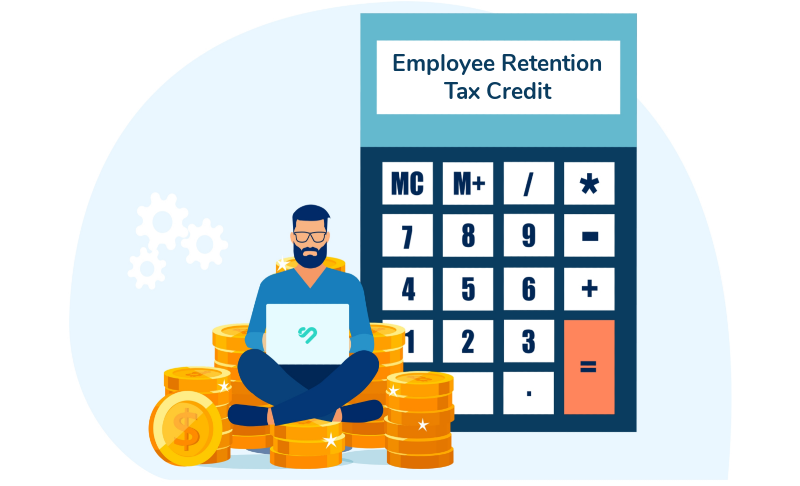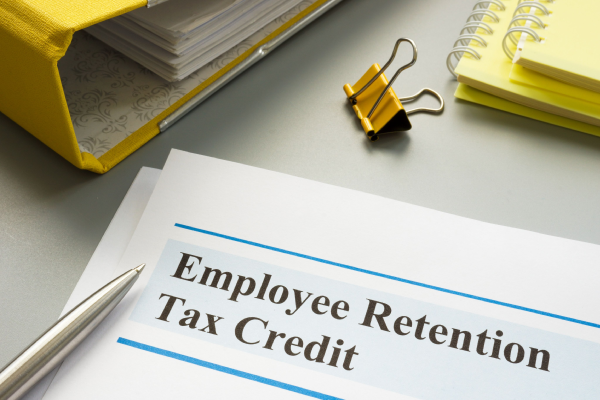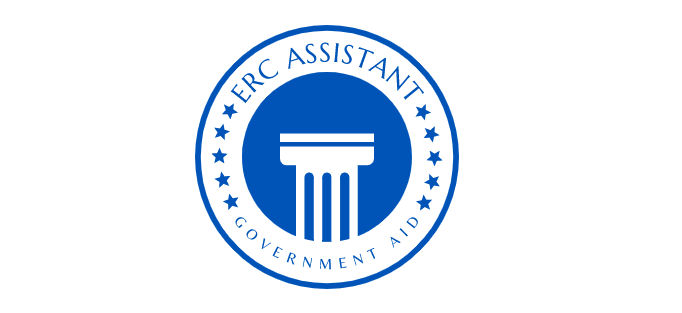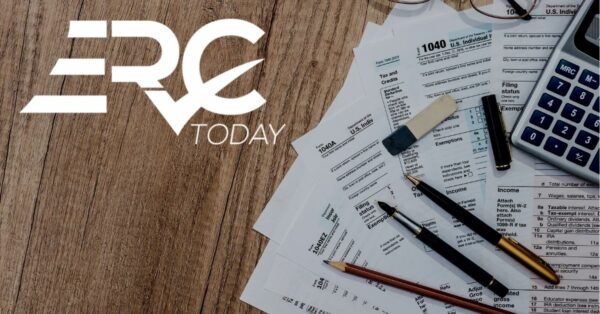Government rules and regulations are notoriously difficult to navigate — dare we say dangerous if a form is filled out incorrectly or mistakes are made when dealing with Uncle Sam.
This causes people and businesses to second guess those rare opportunities and government-funded avenues of support when they do arise.
We saw this with the PPP Loans, and currently, we’re seeing this hesitancy with the Employee Retention Tax Credit (ERTC). The ERTC’s retroactive deadline was January 1, 2022, but it has been pushed back further to October 1, 2021, resulting in qualification changes.
What is the Employee Retention Tax Credit?
The Coronavirus Aid, Relief, and Economic Security (CARES) Act created ERTC to help businesses keep employees on the payroll. The ERTC gives eligible employers and small to medium size businesses the means to receive up to 50% of qualifying wages paid from March 13th to December 31, 2020.
Employers who received a Paycheck Protection Program (PPP) loan are still eligible for the ERTC. The most a company that is granted the ERTC can get is up to $26,000 per employee in the form of a grant.
According to the National Federation of Independent Business (NFIB), only 4% of small business owners are familiar with the ERTC program and many are asking what is ERTC. However, this little-known government aid has massive benefits for businesses.
With employee retention being such a hot topic, the government understands that in order to keep employees around, you’ll still need to be able to pay them. The ERTC serves as a lifeline to help companies and eligible employers and their employees survive the waves of unexpected events that have crashed into them over the last several years.
“Only 8% of owners used ERTC in 2020 and 10% in 2021.” — ERC Today
So how can you capitalize on this government aid? Is there a catch? What are the qualifications?
In this Employee Retention Tax Credit guide, we’ll go over everything (including how to file) you need to know about the ERTC in 2022.
Tip: Take this 60 second quiz to see if you qualify for the ERTC today!
Important Questions To Learn More About The Employee Retention Tax Credit
How does employee retention credit work?
➤ The Employee Retention Credit is a refundable tax credit available to certain businesses that qualify. Based on certain factors such as employee cap and qualified wages, specific business owners are entitled to a percentage of qualified wages an employer pays to employees after March 12, 2020, and prior to January 1, 2021.
Who qualifies for the employee retention credit?
➤ To qualify and be an eligible employer you must be able to prove that your business was negatively impacted in one or more of the following ways: Your business experienced a partial or total shutdown during 2020 or 2021 (includes being limited by commerce, inability to travel, or restricted group meetings), or gross receipt reduction (a business may be eligible for one quarter and not another).
How to apply for employee retention credit?
➤ To apply for the Employee Retention Tax Credit, employers must complete and file Form 941-X, Adjusted Employer’s Quarterly Federal Tax Return or Claim for Refund, with their quarterly federal tax return. For more information on how to apply for employee retention credit, we recommend talking to ERC Assistant to see if you qualify. You can also take this 60-second quiz to start the ERC application process today.
What is the deadline for employee retention credit?
➤ The Employee Retention Credit sunset date was moved from 12/31/21 to 9/30/2021; however, you can still file retroactively as long as you meet the eligibility requirements.
Is the employee retention credit taxable income?
➤ The ERC is not considered taxable income for employees. This means that employees will not have to pay any additional taxes on wages that are covered by the ERC. For employers, the ERC is treated as a Business Expense, which can be used to offset taxes owed. The ERC is a valuable tax relief measure for employers and employees alike, and it can help to retain key personnel during these difficult times.
Can I claim employee retention credit and PPP?
➤ In short, yes. Initially, if you took the PPP loan, you couldn’t claim the ERTC. However, the Consolidated Appropriations Act (CAA) passed in December 2020 rectified that, enabling smaller businesses to seize both opportunities as long as they met the eligibility requirements and followed the rules. It’s important to note that businesses cannot claim a payroll expense as both an ERTC wage and a forgivable payroll cost on the PPP forgiveness application.
What can I spend the employee retention credit on?
➤ The Employee Retention Credit is essentially like a reimbursement, which means you can’t spend the money on whatever you might like. However, it’s considered a fully refundable tax credit, so you’re getting up to 50% of $10,000 in wages per quarter for each employee if you are eligible and were adversely affected by the pandemic.
Can I still claim the employee retention credit?
➤ A recovery startup business can still claim the ERC for wages paid following June 30, 2021, and prior to January 1, 2022. You can also claim the ERC for prior quarters by filling the applicable adjusted employment tax return within the appropriate deadlines.
What are qualified wages for the employee retention credit?
➤ Qualified wages are any wages paid by an eligible employer to an employee after March 12, 2020, and before January 1, 2021. For businesses that have experienced a significant decline in gross receipts or any shutdown due to COVID-19, all wages paid to employees are considered qualified wages. The ERC is a refund in the form of a grant and can return up to $26,000 per employee ($11,000 is the average) depending on wages, health care, and other personnel expenses business owners have already paid. The ERTC is available to all businesses, regardless of size or industry.
Do I have to pay back the employee retention credit?
➤ No. The ERTC is treated as a reimbursement in the form of employer credits, so it’s as if it’s money the government owes you — like you’re being rewarded for making it through these last several years as a business. It is called a loan, but you never have to pay it back.
How much is the ERC credit in 2022?
➤ ERC is a refund in the form of a grant and can return up to $26,000 per employee ($11,000 is the average) depending on wages, health care expenses, and other personnel costs business owners have already paid through the qualifying period.
When does the employee retention credit end?
➤ The ERTC can be claimed for wages paid after March 12, 2020 and before January 1, 2021 (these dates can and do change, resulting in qualification changes as well). To be eligible, employers must have experienced a full or partial shutdown due to a COVID-19-related mandate, or must have experienced a significant decrease in gross receipts.
How long does it take to get an employee retention credit refund?
➤ According to the most recent information from the IRS, forms that have already been filed should expect to result in a reimbursement somewhere between 6-10 months from the date of filing.
Top 3 Best Employee Retention Credit Services
1) ERC Assistant
ERC Assistant is an employee retention credit service that offers a streamlined process for onboarding clients and filing claims in as little as 1-2 weeks. ERC Assistant also has a secure Client Portal protecting sensitive information to protect you from ERC fraud or other malicious parties. You can get an initial ERC estimate at no cost, with minimal time invested on the front end.
Lastly, the ERC Assistant team is able to deliver ready-to-file documents for the IRS without involving your payroll company.
Why this service makes it easy to file your employee retention tax credit: ERC Assistant analyzes whether or not your business qualifies for the ERC Program, what amount you should receive, and any additional technical details that might arise in this otherwise complex process. With the experts at ERC Assistant by your side, you don’t have to worry about navigating it by yourself. They will guide you and outline the steps it will take for you to maximize the claim for your business answering any ERC questions you may have.
Where to learn more: ERC Assistant
2) ERC Today
ERC Today is an employee retention credit service that helps companies evaluate their eligibility, completes a comprehensive analysis of their claim, offers guidance on the claiming process and documentation, gives specific program expertise that a regular CPA or payroll processor might not be well-versed in, and executes a fast and smooth end-to-end process, from eligibility to claiming and receiving refunds.
ERC Today assesses how the PPP loan will factor into your ERC, what the differences between the 2020 and 2021 programs are and how it applies to your business, as well as what the aggregation rules are for larger, multi-state employers and you should interpret multiple states’ executive orders.
Why this service makes it easy to file your employee retention tax credit: With effortless data gathering (including a portal for you to upload your 941 returns, PPP loan documents, and raw payroll data), credit calculation to determine the exact value of the credit you are eligible to receive from the IRS, and help amending returns, ERC Today can walk you through the process from beginning to end. ERC Today has benefited companies of all sizes thanks to their expert services, free consultations, being 100% IRS compliant, minimal upfront costs, and extremely high success rates. There are many examples of companies from various industries benefitting from the ERTC.
Where to learn more: ERC Today
3) Aprio
Aprio’s ERC experts are nationally recognized as COVID relief policy thought leaders. Aprio’s team thinks creatively to maximize your benefits within the confines and regulations of the IRS. In addition to the employee retention credit services the company offers, Aprio works with other credits to increase your company’s liquidity.
The team has dedicated ERC advisors on the forefront of educating the public and leading clients towards maximum COVID relief benefits.
Why this service makes it easy to file your employee retention tax credit: Aprio’s dedicated ERC and PPP advisors have worked on both sides of the relief equation, so they understand how to navigate the complexities and follow the rules and regulations. Their team of more than 50 COVID relief program specialists constantly stays up-to-date with the latest news and information coming from the SBA, the Treasury, Congress, and the IRS.
Where to learn more: Aprio
Things to Know Before Filing Your Employee Retention Credit in 2022
How to claim Employee Retention Credit
To claim the Employee Retention Credit, employers must complete Form 941, Schedule R. The credit is equal to 50% of the qualifying wages paid to each employee through the end of 2021. To be eligible for the ERC credit, employers must have either experienced a disruption in business operations or a decrease in gross receipts. Additionally, employers must maintain their workforce at pre-pandemic levels.
Essentially all businesses qualify for ERC unlike PPP loans since you don’t have to show a decline in revenues but if you do have a decline the grant is automatic.
How to calculate Employee Retention Credit
The credit is equal to 50% of the qualifying wages paid to eligible employees, up to $10,000 of wages per employee per quarter. To calculate the employee retention credit, first determine the number of eligible employees and the total amount of qualifying wages paid to those employees during the relevant quarter.
Qualifying wages are capped at $10,000 per employee for all quarters, so if an employee was paid more than $10,000 in qualifying wages during a quarter, only $5,000 of those wages will be counted towards the credit.
Once you have determined the total amount of qualifying wages paid, multiply that number by 50% to calculate the employee retention credit. For example, if an employer has 10 eligible employees and pays each employee $10,000 in qualifying wages during a quarter, the employer would be entitled to a credit of $50,000 ($10,000 x 10 employees x 50%).
If you have any questions about how to calculate your employee retention credit, please consult with a qualified tax professional.
How much is the Employee Retention Credit
The credit is equal to 50% of the qualified wages paid by the employer to its employees. The maximum amount of qualified wages per employee is $10,000, so the maximum credit that an employer can receive is $5,000 per employee.
To be eligible for the credit, an employer must have experienced a significant decline in gross receipts or been required to suspend operations due to a governmental order related to COVID-19.
In addition, the employer must have retained its employees during the relevant period and paid them at least $600 in qualifying wages during that period. Qualifying wages include salary, hourly pay, commissions, and other forms of compensation. The employee retention credit is available for wage payments made from March 13, 2020 through December 31, 2020.
👉 Tip: Take this 60 second quiz to see if you qualify for the ERTC today!
How to file for employee retention credit
To claim the ERC tax credit, businesses must first file for it with the IRS. Businesses will need to provide basic information about their company and employees, as well as documentation showing that they have been impacted by the pandemic. Start here to begin filing your ERC credit.
The IRS will then review the application and determine whether the business is eligible for the credit. If approved, the credit will be applied to future payroll taxes. For businesses that are struggling to keep their employees, the ERC can provide much-needed financial relief.
How to start the Employee Retention Credit 2022 application
To start the ERC credit, employers must file Form 941, Employer’s Quarterly Federal Tax Return. The credit can be claimed for each qualifying quarter from January 1, 2021, through June 30, 2021. For more information on how to start the employee retention credit 2022 application, visit the IRS website or reach out to an Employee Retention Credit service.
People Also Ask These Questions About The Employee Retention Credit
Q: Why is it important to apply for the employee retention tax credit?
- A: If you do qualify for the employee retention tax credit, chances are that you need and deserve it. A healthy economy has to have healthy businesses, which is why the government is offering the employee tax retention credit in the first place to help out businesses with economic hardship. It is massively important to take advantage of the ERTC to reward yourself and your business for enduring the past several years.
Q: How much does it cost to sign up for the ERC?
- A: Many employee retention credit services take a commission upon acceptance and arrival of the funds to your business. The plus side is that the Employee Retention Tax Credit is the largest government stimulus program in history. Your business may be eligible to receive a grant of up to $26,000 per employee.
Q: How did the Employee Retention Credit change under the CARES act?
- A: Prior to the CARES act, the ERTC credit was only available to businesses that had already shuttered their doors due to COVID-19. However, the new law expands the credit to include businesses that have been forced to reduce operations due to the pandemic. As a result, more businesses will be eligible for the ERTC credit, which can help them offset the costs of retaining employees during these difficult times. In addition, the CARES act also allows businesses to carry forward any unused ERTC credits from 2020 into 2021, providing additional flexibility for businesses that are struggling to retain employees. Ultimately, the changes made by the CARES act will help more businesses keep their doors open and their employees on the payroll.
Q: Where can I find a tool to help me calculate my potential employee retention credit?
- A: There are lots of tools to help you calculate your potential employee retention tax credits. However, the best option is to work with an employee retention credit service to ensure that all rules and regulations are followed correctly for total credit.
Q: What should you know before submitting your employee retention credit application?
- A: Before you submit your ERTC tax credit application, be sure to carefully review all the requirements for eligibility and make sure you meet them. This includes ensuring that you have the proper documentation of any reduced gross receipts during partial or total shutdowns in 2020 or 2021. You will also need to provide proof that employees received qualified wages during this time frame, so make sure you maintain records of employee salary and benefits for the ERTC tax credit program. Ultimately, conducting thorough research and compiling relevant records can save you a lot of time and energy in the long run.
Q: Can you still apply for the ERC program in 2023?
- A: Yes, there is still time to apply for the ERC program in 2023. To claim the ERTC tax credit, you will need to fill out a Form 941-X. Luckily, the statute of limitations for filing amended quarterly returns is up to three years from the date of filing the Form 941. For example, if you are a business owner that qualifies for the ERTC program during the third quarter of 2020, the amended documentation needs to be submitted by October 2023. Businesses have until 2024 to look back on their payroll during the qualifying period and apply for the ERC tax credit.
















